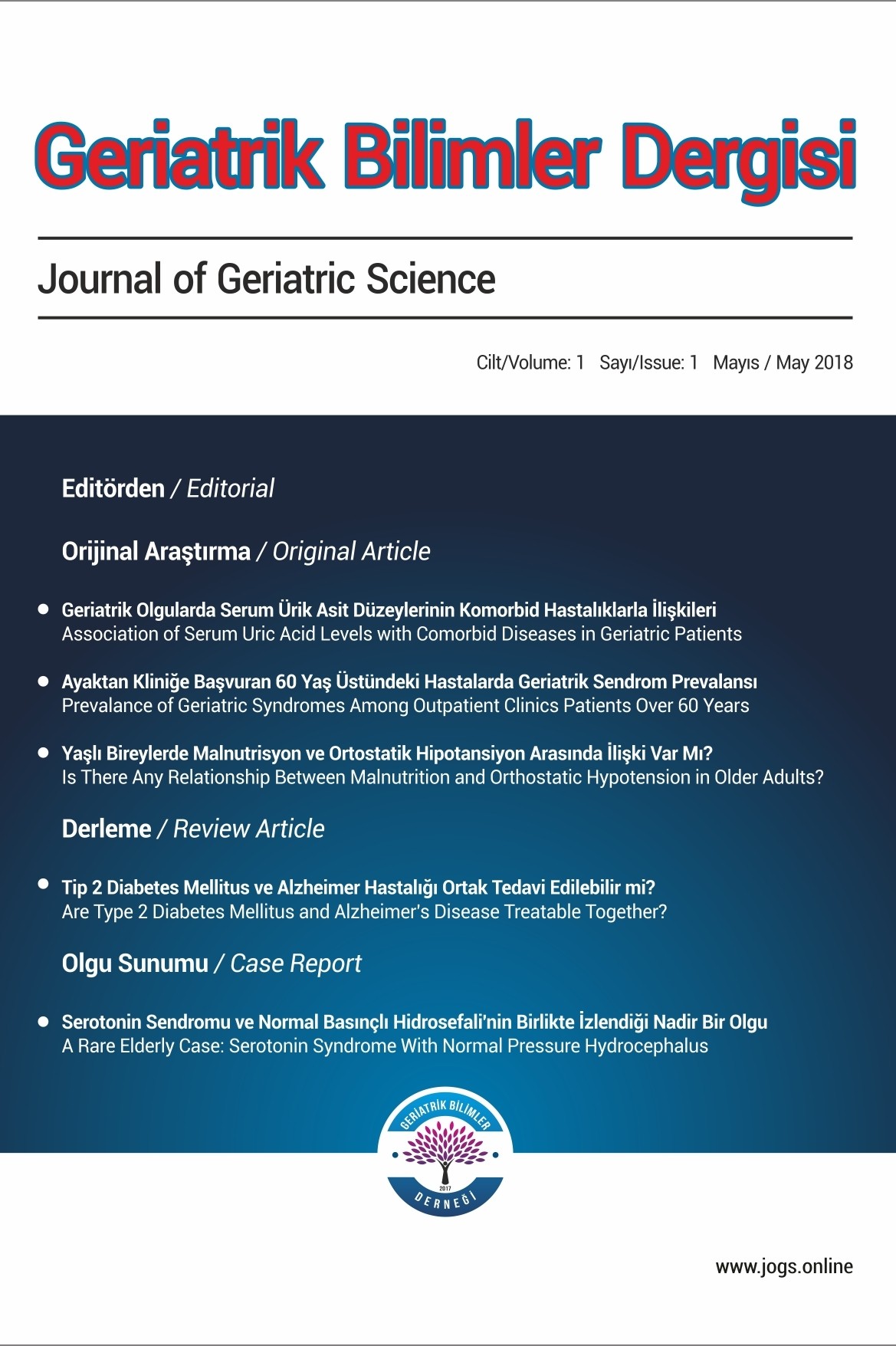Geriatrik Olgularda Görülen Kırıklar
Epidemiyoloji, geriatri, kırık, mevsim
Fractures in Geriatric Cases
Epidemiology, geriatrics, fracture, season,
___
- 1. Burge R, Dawson-Hughes B, Solomon DH, Wong JB, King A, Tosteson A. Incidence and economic burden of osteoporosis related fractures in the United States, 2005e2025. J Bone Min Res 2007;22:465e75
- 2. Blume SW, Curtis JR. Medical costs of osteoporosis in the elderly medicare population. Osteoporos Int 2011;22(6):1835e44.
- 3. Aschengrau A, Seage G. Essentials of Epidemiology in Public Health. Jones & Bartlett Learning; 2008.
- 4. T.C. Tarim Ve Orman Bakanliği Meteoroloji Genel Müdürlüğü Available at:https:// www.mgm.gov.tr/veridegerlendirme/il-ve-ilceler-istatistik.aspx?m=TOKAT
- 5. Koca K, Ersen O, Akpancar S, Akyıldız F, Gürer L. Demographic Features of Patients with Extremity and Spine Fractures in Emergency Departments. Journal of Academic Emergency Medicine 2017; 16(1), 19.
- 6. Burge R, Dawson-Hughes B, Solomon DH, Wong JB, King A, Tosteson A. Incidence and economic burden of osteoporosisrelated fractures in the United States, 2005e2025. J Bone Min Res 2007;22:465e75.
- 7. Cauley JA. Public health impact of osteoporosis. J Gerontol Ser A Biol Sci Med Sci 2013;68(10):1243e51
- 8. Mandıracıoğlu A. Dünyada ve Türkiye’de yaşlıların demografik özellikleri. Ege J Med. 2010;49(3):39–45.
- 9. Abrahamsen B, Van Staa T, Ariely R, Olson M, Cooper C. Excess mortality following hip fracture: a systematic epidemiological review. Osteoporos Int. 2009;20(10):1633–50.
- 10. Burge R, Dawson-Hughes B, Solomon DH, Wong JB, King A, Tosteson A. Incidence and economic burden of osteoporosisrelated fractures in the United States, 2005e2025. J Bone Min Res 2007;22:465e75.
- 11. Kanis JA, Oden A, Johnell O, De Laet C, Jonsson B, Oglesby AK. The components of excess mortality after hip fracture. Bone. 2003;32(5):468–73
- 12. Kanis JA, Odén A, McCloskey EV, Johansson H, Wahl DA, Cooper CA. Systematic review of hip fracture incidence and probability of fracture world- wide. Osteoporos Int. 2012;23(9):2239–56.
- 13. Silveira VAL, Medeiros MMC, Coelho Filho JM, et al. Incidência de fratura do quadril em área urbana do Nordeste brasileiro. Cad Saúde Pública. 2005;21(3):907–12.
- Yayın Aralığı: Yılda 3 Sayı
- Başlangıç: 2018
- Yayıncı: Geriatrik Bilimler Derneği
Uzman Görüşü: Yaşlılarda Metformin Kullanımı ve B12 Vitamin Eksikliği
Fatma Sena DOST GÜNAY, Ahmet Turan IŞIK
Geriatrik Olgularda Görülen Kırıklar
Postmenopozal Yaşlıların Beslenme Durumunun Değerlendirilmesi
Ayşe Hümeyra İSLAMOĞLU, Muazzez GARİPAĞAOĞLU, Havvanur YOLDAŞ İLKTAÇ, Fatma Esra GÜNEŞ
Geriatrik Sendromlarda Düşme Sıklığı
Neziha ULUSOYLAR, Fatma Sena DOST GÜNAY, Özge DOKUZLAR, Saadet KOÇ OKUDUR
Türkiye'de Gerontoloji Atlası: Yaşlı Yoksulluğu ve Yalnızlık Üzerine Bulgular
İsmail TUFAN, Aslı KILAVUZ, Özlem ÖZGÜR, F.Sıla AYAN, Faruk Yaşar GÜRDAL, Berkay ENGİN
